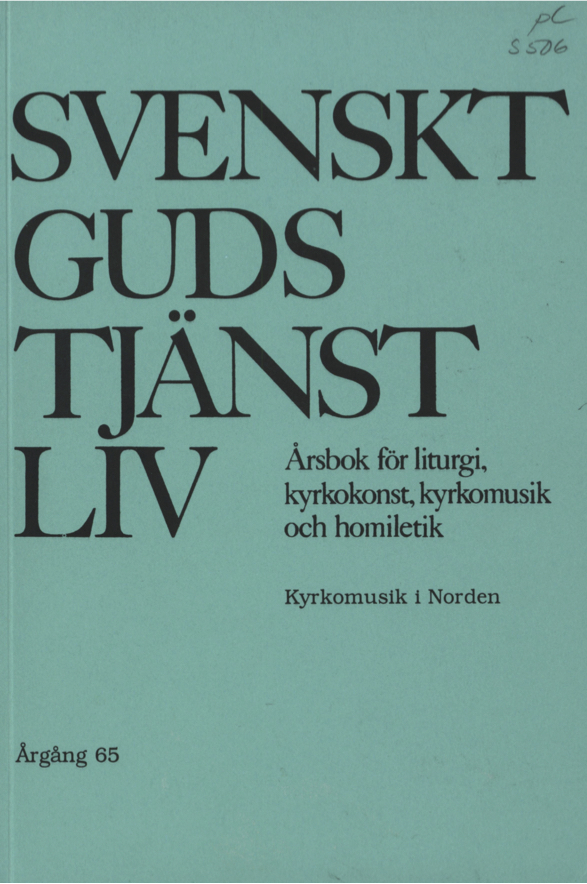Den kyrkomusikaliska utvecklingen i Sverige efter andra världskriget
Abstract
Musical life in the Church of Sweden is now, at the beginning of the 1990’s, more diversified than ever, e.g. regarding: 1) the performers; their age, technical skill, the stylistic range of their repertoire, 2) the places of musical activity; churches, parish halls, other rooms, 3) the hymn books available, choral anthologies, new works for organ, etc. This short survey makes no claim of completeness, but some help do delve deeper into the subject may be provided by the book list at the end of the article.
In 1945, the overwhelming majority of Sweden’s church musicians were also teachers at elementary schools; with officially regulated tasks, they were called “skolkantor”. The schools’ compulsory short morning prayer - with hymns - made singing and organ playing (or at least harmonium) into obligatory subjects at the teachers’ seminars. Those who wished could attend summer courses leading up to the lower organist exam. Only the largest parishes, mostly in towns, had church musicians with higher musical education, and they were often teaching music at secondary schools, as well.
The strong bonds between church and school have by now been severed, which means less natural contact with prospective young choristers, and an increasing number of adult choristers who know next to nothing about the hymn book.
Since 1989, the church musicians are no longer state-employed, but locally so, divided into two graduated categories: “kantor” with a two-year education, available at five schools, and “organist” (about 30% of the total number of 2.000) with about five years of post-secondary school education. As many small parishes share a “kantor” with up to three neighbouring ones, it means that very few of Sweden’s 3.000 parishes are without a church musician, and it also means that church choir singing is a real grass-root movement.
In 1939, the music for the 1937 hymn book came out. It shared the striving of the - future - Prayer Book of 1942 for dignified and artistically qualified liturgical music, including the reintroduction of plain-song Introits (in Swedish).
The 1950’s restored the vigorous rhythm of many 16th and 17th century chorales, and the 1960’s saw the publication of specific children’s songs, and also of rather controversial guitar-accompanied youth songs. The continuous work on renewing liturgy and congregational singing was an inspiration for a large production of new hymns and other liturgical music. The hymn book supplements of 1976 and 1982 were finally replaced by a new hymn book in 1986, the first 325 items of which are common to 14 denominations.
As to other music within the liturgical frame, each decade has had its own trends and characteristics, as the:
1940’s; four-part a cappella singing is the rule for church choirs, even for the popular Bach chorales. New choir and organ music show the same unsentimental linearity with a national flavour.
1950’s; rhythmic chorales come into focus, often introduced by “alternatim” singing after Reformation time model: choir verse 1, 3, 5, etc, and congregation 2, 4, 6. Hugo Distler’s linear, rhythmically compli cated and mildly dissonant style is much admired.
1960’s; many new children’s choirs are being started, especially in large parishes, and they often work with Orff instruments. Bible songs with guitar, negro spirituals etc, become enormously popular in youth work, but most church musicians doubt their mu sical and liturgical value. Organ music explodes into modernism, but also into more traditional, colourful pieces. French romantic organ sound and music are rediscovered.
1970’s; African and Asian Church mu sic becomes popular, especially at mission bids. The guitar songs get more and more accepted among church musicians, and more elaborate instrumental accompaniments are published. Swedish folk music is liberated from its heavy romantic costume, mainly in the forms of bouncy choir settings of old regional hymn tunes.
But the most spectacular event of the 70’s was the final reorientation of choral sound and repertoire, from the German tradition to the English one. Combined with the pioneer work of Eric Ericson and his pupils, which had begun as early as the 50’s, it has brought about an incredible expansion of Swedish choral singing, both in quantity and in quality.
Romantic church music definitely “came in from the cold”, requiring adequate organs.
1980’s; children’s choirs are taken seriously, and most half-to-full-time church musicians have one, even in small parishes. Young people prefer gospel choirs with regular beat accompaniment, and a certain influence from pop music is noted all over the field.
The Schiitz-Bach-Handel anniversary in 1985 was abundantly celebrated as “the year of church music”, organized by the various church music associations. There were music festivals, new editions, new compositions ordered for the occasions, symposiums on baroque performance, etc.
During the last thirty years, Swedish church music has flourished as probably never before. Its future seems threatened, though: materially, by the fast approaching disestablishment of the Church of Sweden, and spiritually, by the Church’s theological and moral weakness. But 1985 taught us what could be done even in the midst of “the thirty-year war”, soli Deo gloria!
Downloads
Publicerad
Nummer
Sektion
Licens
© författarna, Laurentius Petri Sällskapet för svenskt gudstjänstliv samt Artos & Norma bokförlag. Det är tillåtet att kopiera och använda material ur Svenskt Gudstjänstliv för forskningsändamål om källan anges. För övriga ändamål kontakta respektive artikelförfattare samt förlaget. Särskilda restriktioner kan gälla för bildmaterial.


